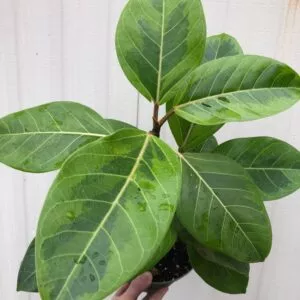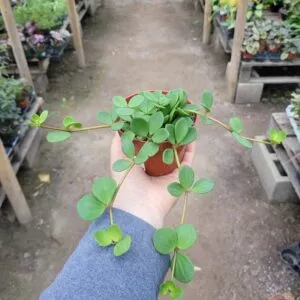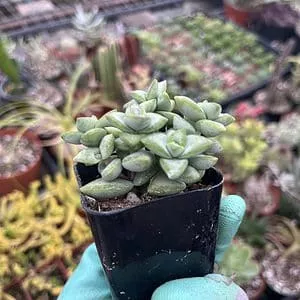No products in the cart.
The Viburnum plicatum var tomentosum fits well with its horizontal branches into the landscape or the right container size.
The white flowers add interest to the garden from April to May. Then, as autumn arrives, the green foliage turns burgundy red.
So, why not add these deciduous shrubs to the garden with our care guide here?
Plant Name: Viburnum plicatum tomentosum ‘Mariesii’
Other Name: Doublefile Viburnum
Plant Type: Deciduous shrub
Native Areas: Asia
Light Requirement: Full Sun to Partial Shade
Watering: Average
Fertilizer: General-purpose fertilizer
Toxicity: Non-toxic to humans and pets
Temperature: Moderate Climate Conditions
Propagation: Softwood Cuttings
Growth: 8-16 feet tall and 12-15 feet wide
Soil Type: Well-Drained Soil
USDA Hardiness Zones: 5-8
More About Doublefile Viburnum
 Viburnum plicatum f. tomentosum ‘Mariesii’ @andrewmorffew
Viburnum plicatum f. tomentosum ‘Mariesii’ @andrewmorffew
The Viburnum plicatum var tomentosum ‘Mariesii,’ better known as the Doublefile viburnum, is an exceptional addition to the garden—the deciduous shrub blooms white flowers with dark green foliage.
It is a dense multi-stemmed shrub with an oval shape and is very attractive with its fall color of burgundy red. The flowers form like flat clusters, and you see tiny red fruit with seeds once it fades.
You can use the Doublefile viburnum as a single specimen plant for foundation planting or in a shrub border to massed screens. The best part is these shrubs are easy to grow and have few problems as foundation plantings.
You can plant them in the fall to enjoy the moderate growth to fill the landscape.
Doublefile Viburnum Care
Most Viburnum species need consistently moist soil to direct sunlight to develop fertile flowers.
Still, the plant can tolerate shade, and it also helps to amend the soil with compost for added drainage if growing in clay soils.
Pruning is also needed to control the size and shape and needs to be done after the flower clusters fade. One thing is for sure the berries will attract birds to the garden.
Recommended Soil For Viburnum Plicatum

Flowering plants benefit mainly from organic matter or compost for healthy and beautiful blooms. But if you can’t find one near you, you can also check our organic potting mix product on our website.
The Viburnum plicatum var also thrives well with acidic to alkaline soil, but they adapt well to most soil types. We recommend loamy, well-drained soil made for similar outdoor plants like Azaleas and Rhododendrons.
Light Exposure For Those Dark Green Leaves and Flower Color
You can grow your Doublefile viburnum standing in full sun to part shade. Yet with direct sunlight, you will get the best cut flowers.

Watering Needs For This Large Shrub
During the first growing season, it helps to keep your shrub watered well to establish those horizontal branches and the root system.
During the summer months, you may need to water deeply if there is a lack of rainfall. While the shrub can tolerate drought once, mature, it prefers moist soil.
Therefore, during the winter, you can refrain from watering often.
With High Temperatures Provide Partial Shade
Viburnum plicatum var tomentosum prefers moderate climates and does not do well in scorching weather.
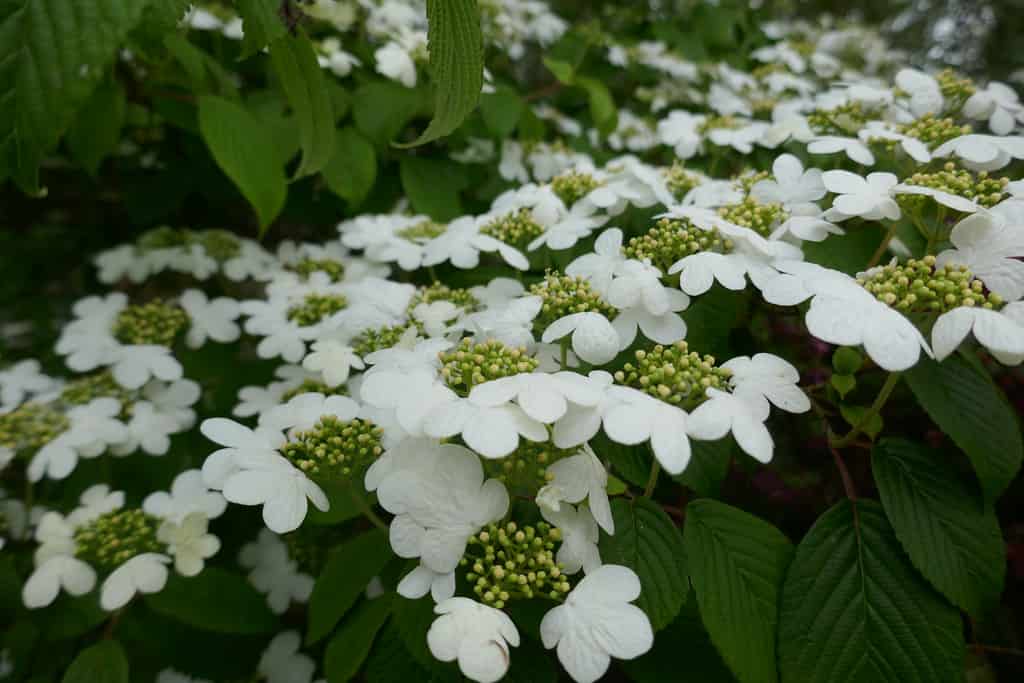 Viburnum Plicatum @bernardblanc
Viburnum Plicatum @bernardblanc
If you live in a hardiness zone with excessive heat, we recommend providing the shrub with some shade. Another great thing to do is add mulch around the base of the shrub to keep the soil cool.
Similar to cold weather, frost can damage the foliage.
Fertilizing Viburnum Plicatum
The Doublefile viburnum appreciates some feeding using a balanced slow-release fertilizer given in early spring. Yet, we recommend following the product label as additional feedings are unnecessary to bloom those gorgeous white flower clusters.
Pruning Your Shrubs
From early summer to fall, you can prune your Viburnum plicatum after the flowers fade. The reason for doing this is that it blooms on the old wood and allows for new growth to develop the following growing season.
You give your shrubs a little prune at any time. But hard pruning is needed every few years. You can remove the horizontal branching rubbing against each other. Also, remove the water sprouts to suckers found at ground level.
Overwintering
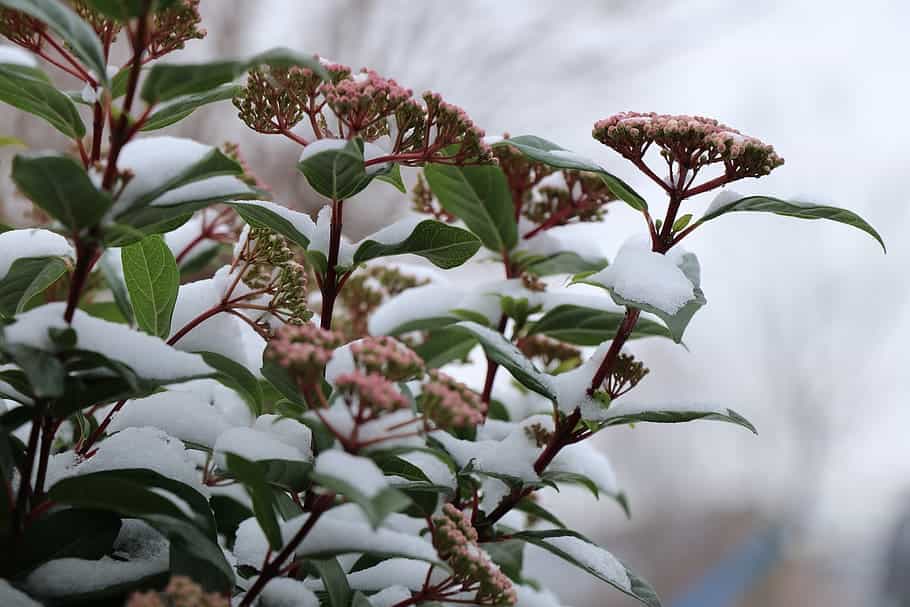
The Doublefile viburnum needs special care in the hardiness zone five and six. These shrubs are shallow-rooted that can be damaged by frost.
To protect them, add some mulch around the base and wait with water until early spring arrives. For extreme freezing temperatures, you can wrap your plant using burlap.
Propagating Viburnum Plicatum var Tomentosum
While you do get fertile flowers forming red fruit with seeds growing them in this way takes very long. The best is to use softwood cuttings in spring as new growth begins on the branches’ tips. Here are some helpful tips for propagating from the stems:
Take a five-inch segment from a softwood branch from the tip. Ensure that the stem cutting has at least two pairs of leaves. Make your cut one inch below the second set of leaves. Remove the lower two leaves to form a wound where new growth begins.
Take the cut end and dip it in a rooting hormone, as it helps improve the rooting process.
Fill a seed tray with a potting mix of 60% sand or perlite mixed with 40% peat moss. Ensure the container has drainage holes and plant the cutting with buried leaf nodes.
Water deeply, allow the excess moisture to drain, and place it in a resealable plastic bag to form a dome. Keep the tray in a shady spot receiving sun for most of the morning.
New growth should appear after five weeks, and once the roots poke through the drainage holes, you can transplant it to a container size of four inches. Leave the plant to grow until it is tall enough to move to the landscape.
Doublefile Viburnum Varieties
You can find different species to grow in the garden in the Viburnum genus.
Viburnum cassinoides

The Witherod viburnum is native to North America and can reach up to 12 feet high when mature. It forms flat-topped flower clusters.
In late spring, the flower color is white and small but does not smell great. The fall color of the foliage is orange-red to purple.
The berries are edible and start green but turn to a red-blue color and black in the fall.
Viburnum var. lantana ‘Aureum’

The Golden wayfaring tree grows well in the hardiness zone 3-7 at 8 feet. The flowers and fruit is similar to the
Witherod viburnum, but there is a difference in the foliage color. New foliage starts with gold-yellow fading to green, while autumn is yellow.
Doublefile Viburnum Common Diseases and Pests
While the Viburnum plicatum var tomentosum ‘Mariesii’ is a low-maintenance plant to some extent, it can still be bothered by pests and disease. You will need to keep an eye on viburnum leaf beetles to aphids.
You can use Neem oil spray to kill the aphids when you spot them as a preventative measure. The beetle is a serious problem as you need to target the larvae. We recommend using biological control to bring in other predaceous insects.
Some other common problems are:
It is a fungus when you notice black, pale green, or reddish brown spots on the leaves. It can happen with overhead watering as the foliage remains wet. We recommend removing the spotted leaves and raking up any fallen infected leaves. Then use a fungicide spray to control the situation.
If the foliage turns white or gray on the upper and lower parts, it can be powdery mildew or downy mildew. The best is not to do overhead watering and water at the potted plants‘ base. Follow the same procedure as previously mentioned.
Frequently Asked Questions
The Viburnum plants can live between 50 to 150 years when taken care of correctly.
The Viburnum burkwoodii Anne Russel is the most fragrant shrub, as the flowers have a sweet scent.
The Viburnum species do not have invasive roots and grow well as shrubs to form a privacy screen.
The Viburnum tinus is the hardiest shrub to grow as it can tolerate excessive summer heat and is somewhat drought tolerant.
The Doublefile viburnum is not a rare plant. You can find them at your local garden center or with us at Plantly.
Whether you want to buy, sell, or simply reach out to other plant enthusiasts, Plantly is the right place to be!
-
$19.95Sold By: SunSoul Plants
$32.95In stock
Ficus Altissima ‘Yellow Gem’ in 6″ pot
Rated 4.87 out of 5 based on 98 customer ratings05Sold By: SunSoul Plants -
$6.00 – $12.00Sold By: Plants by Stinky Boo
In stock
Peperomia Hope
Only 20 available and it’s in 2 people’s basketRated 5.00 out of 5 based on 2 customer ratings00Sold By: Plants by Stinky Boo -
$4.59Sold By: Cacti and Exotica
In stock
Crassula | String of Buttons | 2″ Pot
Rated 4.98 out of 5 based on 59 customer ratings00Sold By: Cacti and Exotica -
$7.00Sold By: Painted Petals and More
In stock
Nephthytis — Arrow plants
Rated 4.78 out of 5 based on 64 customer ratings00Sold By: Painted Petals and More
